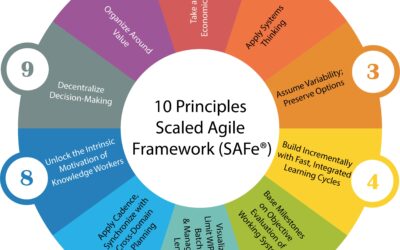Lean Agile Portfolio
The business landscape is in a constant state of flux. With the ever-evolving needs of consumers and the rapid pace of technological innovation, organisations have realised the importance of agility in managing product and delivery portfolios. Lean-Agile Portfolio acts as the bridge between organisational strategy and execution. Organisations can navigate today’s volatile business environment with clarity and agility by aligning projects with strategic themes, optimising value streams, and promoting lean-agile principles. Learn how to lead a Lean Agile Portfolio.
An agile portfolio refers to a collection of investment initiatives and projects an organisation pursues, viewed through lean agile principles. This means maximising value while minimising waste and ensuring that work aligns with strategic goals in an adaptable manner.
Elements of a Lean-Agile Portfolio
When looking at a Lean-Agile Portfolio, it’s essential to understand its core components:
- Strategic Themes: These are the long-term organisational goals that guide the portfolio’s direction. They provide a link between the organisation’s mission and the portfolio backlog.
- Portfolio Backlog: A prioritised list of projects and programs. They are selected based on their potential value to the organisation and aligned with strategic themes.
- Value Streams: These identify the steps that deliver value to the end customer, from concept to cash. Recognising and optimising these streams is vital to ensuring the lean flow of value.
- Agile PMO (Project Management Office): A modern twist to the traditional PMO, the Agile PMO ensures governance, facilitates lean-agile budgeting, and provides guidance without being prescriptive.
- Epic Owners: They oversee the development of more significant initiatives that span multiple teams and releases.
- Metrics and KPIs: Key Performance Indicators and metrics provide quantitative insights into the portfolio’s health and ability to deliver value.
Agile Portfolio Operations: The Heartbeat of an Effective Portfolio
Once a Lean Agile Portfolio is set up, the focus shifts to its day-to-day operations. Agile Portfolio Operations refer to the recurrent activities that ensure the portfolio’s smooth running, governance, and adaptive recalibration to meet organizational goals. Let’s explore its nuances:
What’s Involved in Agile Portfolio Operations?
- Governance: This is the structured framework used to make consistent and coherent decisions across the portfolio. Agile governance emphasizes principles over processes and flexibility over rigidity. It seeks to balance organizational control with team autonomy.
- Planning: An ongoing, iterative process where strategic themes are translated into tangible projects and initiatives. Agile planning takes a rolling-wave approach, allowing for adjustments as market conditions, organizational priorities, or technical landscapes change.
- Forecasting: Agile forecasting is adaptive, unlike traditional forecasting, which is often fixed and linear. By analyzing current data, trends, and feedback, future projections are continuously adjusted to reflect changing realities.
- Performance Measurement: KPIs and other metrics are used to gauge the portfolio’s health, initiatives’ progress, and value delivery rates. This is crucial for ensuring that the portfolio remains aligned with strategic objectives.
- Stakeholder Engagement: Regular touchpoints with stakeholders ensure alignment, gather feedback, and facilitate necessary adjustments. It ensures the portfolio stays relevant and value-driven.
- Risk Management: In an agile context, risks are continuously identified, assessed, and mitigated. This proactive approach ensures that potential impediments are addressed promptly.
- Resource Allocation: Agile portfolio operations involve the dynamic allocation of resources (people, tools, budget) based on priorities, ensuring that the most critical initiatives are adequately resourced.
How to Set up a Lean-Agile Portfolio
Setting up a Lean-Agile Portfolio is about more than just understanding its elements but systematically implementing them. Here’s a step-by-step approach to how to do so:
- Define Strategic Themes
- Map Out Value Streams
- Create the Portfolio Backlog
- Establish the Agile PMO
- Empower Epic Owners
- Adopt Lean Budgeting Practices
- Foster Feedback Loops
- Promote Decentralised Decision-making
- Cultivate Collaboration
Contribution to Organisational Value and Alignment with Agile Delivery
Why adopt a Lean Agile Portfolio approach?
- Enhanced Alignment: A Lean Agile Portfolio ensures that all initiatives are aligned with the organisation’s strategic goals, promoting better ROI.
- Faster Time-to-Market: By focusing on value streams and reducing waste, organisations can deliver value to their customers faster.
- Flexibility: Given its adaptive nature, the portfolio can quickly respond to market changes or new opportunities.
- Improved Governance: With the Agile PMO, there’s a balanced blend of guidance and flexibility, leading to more efficient project management and better resource utilisation.
- Value-Centric Approach: Every decision, from funding to project prioritisation, revolves around delivering maximum value.
Optimise your strategy and delivery with a Lean-Agile Portfolio. Because in the modern business world, agility isn’t just an advantage—it’s a necessity.

